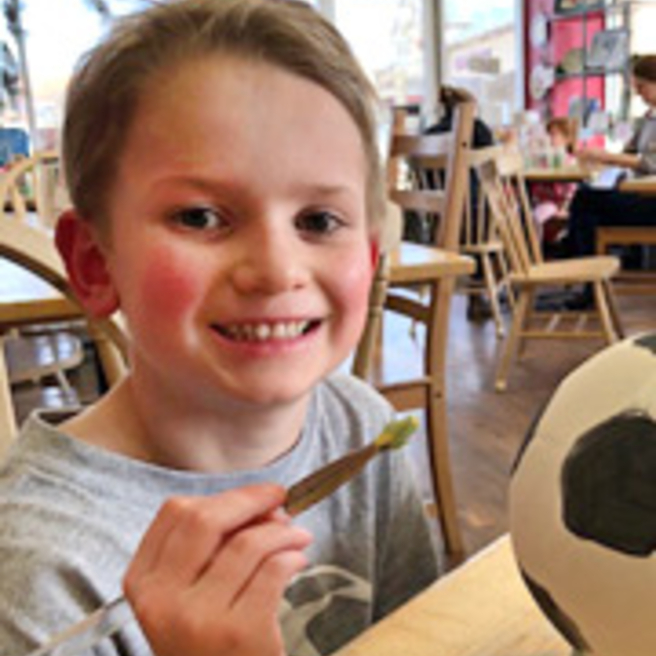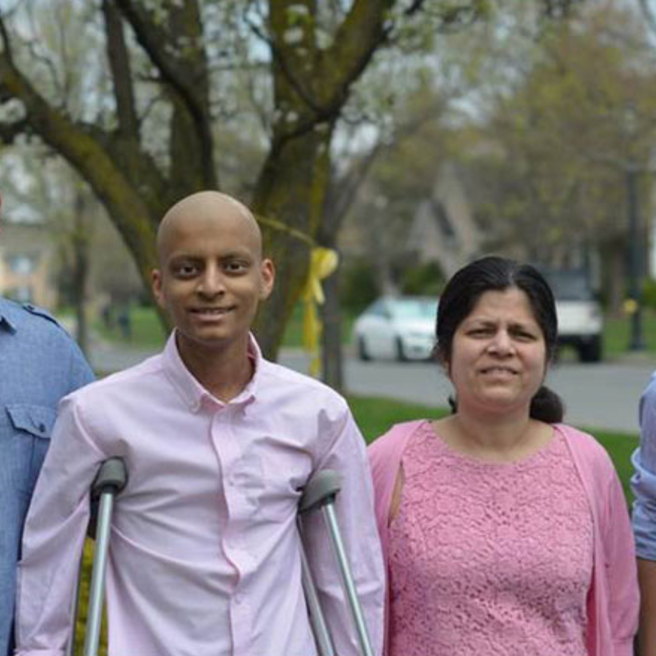What is osteosarcoma?
Osteosarcoma is the most common malignant (cancerous) bone tumor among children, adolescents and young adults, but it is still a rare disorder. This bone cancer affects approximately 400 children younger than age 20 every year in the United States.
Osteosarcoma occurs most often in children and young adults between the ages of 10 and 20 and often during a growth spurt. It occurs more frequently in boys than girls.
Osteosarcoma is a bone cancer, but it can spread to other organs or tissues in the body, most commonly starting with the lungs.
Causes of osteosarcoma
Most of the time, the cause of osteosarcoma is unknown. Sometimes, genetics cause an increased risk of cancer, including osteosarcoma, in families. Our cancer predisposition team can help evaluate potential genetic causes of osteosarcoma.
Signs and symptoms of osteosarcoma
The symptoms of osteosarcoma depend on the size and location of the bone tumor, as well as your child’s age and general health.
Your child’s symptoms may include:
- Pain, stiffness or tenderness at the site of the tumor
- Pain that gets progressively worse over time, and may radiate outward from the tumor site
- Pain that awakens the child from sound sleep
- Swelling or mass around the affected bone
- Difficulty walking or limping
- Weak bones, which may lead to a fracture
Osteosarcomas located near the spinal cord may cause back pain that radiates out through the arms or legs.
Testing and diagnosis for osteosarcoma
Many symptoms of osteosarcoma can be easily ignored as normal growing pains in children, which makes regular check-ups and referrals to specialists extremely important. Prompt diagnosis and identification of cancer is crucial to successful treatment.
If your child has been referred to an orthopedic or oncology specialist, your child’s diagnostic evaluation will begin with a thorough medical history and physical examination. A detailed neurological assessment may also be performed. This involves a series of questions and tests to check your child's brain, spinal cord and nerve function.
At Children’s Hospital of Philadelphia (CHOP), clinical experts use a variety of diagnostic tests to diagnose tumors, including:
- X-rays, which produce images of bones.
- Magnetic resonance imaging (MRI), which uses a combination of large magnets, radiofrequencies and a computer to produce detailed images of organs, soft tissues, muscles, ligaments and other structures within the body. Your child is exposed to no radiation during an MRI.
- Computed tomography (CT) scan, which uses a combination of X-rays and computer technology to examine bones and other regions, such as the lungs, and produces cross-sectional images ("slices") of the body.
- EOS imaging, an imaging technology that creates 3-dimensional models from two flat images. Unlike a CT scan, EOS images are taken while your child is in an upright or standing position, enabling improved diagnosis due to weight-bearing positioning.
- Positron emission tomography (PET) scan, which uses radioactive sugar injected into a vein and a scanner to make detailed, computerized pictures of areas of the body.
- Needle biopsy, which is a procedure where a doctor places a small needle through the skin and into the lesion to withdraw a small sample of the abnormal tissue. The tissue is analyzed to confirm the diagnosis.
In addition to diagnosing the specific type of cancer your child may have, these tests will also help determine the size and location of the tumor, and stage of the cancer. All this information is crucial in determining the best treatment options for your child.
Treatments for osteosarcoma
At CHOP, experts at the Bone and Soft Tissue Tumor Program take a team approach to treatment. Orthopedic surgeons, oncologists and other specialists collaborate to provide your child with individualized care and the best possible outcomes.
Our orthopedic oncology program is led by Kristy L. Weber, MD, and Alexandre Arkader, MD, nationally renowned surgeons who specialize in treating bone and soft tissues tumors, limb-sparing surgery and reconstructive surgery. They work closely with oncologists from our Solid Tumor Program to care for children with osteosarcoma.
Unlike benign musculoskeletal tumors that may require only “watchful waiting” to see if pain or dysfunction develops, malignant bone tumors require active treatment.
Chemotherapy
Initial treatment for osteosarcoma always involves chemotherapy. Chemotherapy refers to medicines that help fight cancer. These medicines are usually given before and after surgery. This helps target the primary tumor as well as any cancer cells that may have already spread but may not yet been detected.
In most cases, chemotherapy is given to your child through an implantable venous port in the chest. This port remains in place for the duration of therapy and helps your child avoid multiple needle sticks.
If osteosarcoma comes back after initial treatment, we offer both standard of care options and a number of clinical trials through our Center for Precision Medicine for High-Risk Pediatric Cancer and our Developmental Therapeutics Program.
Surgery
There are two goals of surgery in treating osteosarcoma:
- To remove the tumor
- To preserve or restore function at the site of the tumor
Surgery is always performed at the site where the tumor started (primary site). Sometimes, surgery is also recommended to remove sites where the tumor has spread (metastases).
About 90 percent of children with osteosarcoma can be treated with limb-sparing (also known as limb-salvage) and reconstructive surgery. CHOP surgeons regularly perform these complex surgeries and are constantly working to improve outcomes for children with the most difficult-to-treat tumors.
Limb-sparing surgery is performed under general anesthesia. It involves cutting out the tumor and a margin of healthy tissue surrounding it. Depending on the size and location of the tumor, as well as your child’s age and stage of growth, surgeons may use a variety of reconstructive methods to restore your child’s body function.
Reconstruction may include:
- Joint replacement if your child’s osteosarcoma is located on or near the knee, hip or shoulder. If your child is still growing, a modified joint replacement that can be expanded as your child grows may be used.
- Allograft (cadaver bone) if your child’s tumor is in the middle of an arm or leg bone. This replacement bone serves as a structural filler — giving your child’s limb more strength and durability as their own bone grows around it.
- Free vascularized fibular grafting if your child’s tumor is in the thigh bone. This procedure includes moving one bone from your child’s lower leg to replace a diseased thigh bone. This may be done along or in conjunction with an allograft.
In about 10 percent of cases — because of the size or location of the tumor — osteosarcoma cannot be removed with limb-sparing surgery. In these rare situations, two surgical options exist:
- Amputation of the affected limb
- Functional amputation (rotationplasty): CHOP is one of very few hospitals offering this complex surgery in which the ankle assumes the function of a knee. Children can resume active lifestyles and have almost normal function.
After surgery for osteosarcoma, your child should expect to stay two to five days in the hospital.
Surgical safety
Though surgery for malignant tumors is highly effective, we understand that any surgery can be a stressful experience for children and families. At CHOP, we offer a wealth of resources about how to prepare your child for surgery and what to expect during surgery.
Additionally, we employ numerous best practices before, during and after surgery to decrease the risk of infection and improve your child’s outcome. For more details about safety protocols at Children's Hospital of Philadelphia, see safety in surgery.
Radiation therapy
In rare situations, radiation therapy may be an option to treat osteosarcoma. Radiation therapy uses high-energy waves such as X-rays to kill or shrink cancer cells.
CHOP, in collaboration with Penn Medicine, also offers proton therapy to children at the Roberts Proton Therapy Center.
Proton therapy is an innovative form of radiation treatment that is only available at select hospitals across the nation. The greatest benefit of proton therapy is that it delivers most of its energy to a very narrow field at the location of the tumor — making it less damaging to the surrounding healthy tissue.
Follow-up care
Following completion of treatment, we strongly recommend continued follow-up with our multidisciplinary team. Together, we will monitor for possible recurrence of the cancer and manage any side effects from treatment.
During follow-up visits, imaging of the tumor site and areas where the tumor could spread are recommended to check the reconstruction and make sure there is no recurrence. The team will also recommend periodic blood tests and screening studies to evaluate for long-term side effects of chemotherapy. Our Childhood Cancer Survivorship Program helps patients and their families monitor for and treat any side effects that develop.
If your child had reconstructive surgery, they may require long-term follow-up care to monitor the joint replacement, allograft or fibular grafting. Children who had a limb amputation or rotationplasty will need to be fitted with a prosthetic and receive routine adjustments as they grow.
Follow-up care and ongoing support and services are available at our Main Campus and our specialty care centers in King of Prussia, PA, and Voorhees, NJ. Our team is committed to partnering with parents and referring physicians to provide the most current, comprehensive and specialized care possible for your child.
Children who need continued monitoring into adulthood can continue to see some of the same doctors who treated them. CHOP’s Bone and Soft Tissue Tumor Program works closely with Penn Medicine. For families that live farther away and need continued monitoring, our clinical professionals will help your child transition to adult care near home.
Outlook
Children's Hospital of Philadelphia has an excellent track record of treating children diagnosed with bone cancers like osteosarcoma. Both the Orthopedic Center and the Cancer Center are consistently ranked among the best in the nation by U.S. News & World Report.
As with any cancer, prognosis and long-term survival can vary greatly from child to child, however. Prompt medical attention and aggressive therapy are important for the best prognosis.

Get a Second Opinion from CHOP
Our experts are here to review your child's diagnosis and treatment plan, and work with primary oncologists as needed
Resources to help
Osteosarcoma (bone cancer in children) Resources
Bone and Soft Tissue Tumor Program Resources
We have compiled web, video and other resources to help you find answers to your questions and help you feel more confident in the care you are providing your child.
Reviewed by Alexandre Arkader, MD


